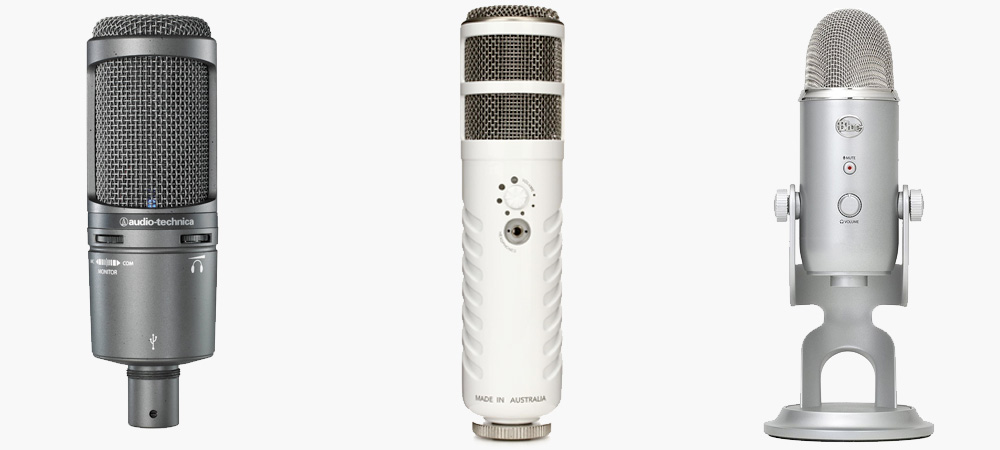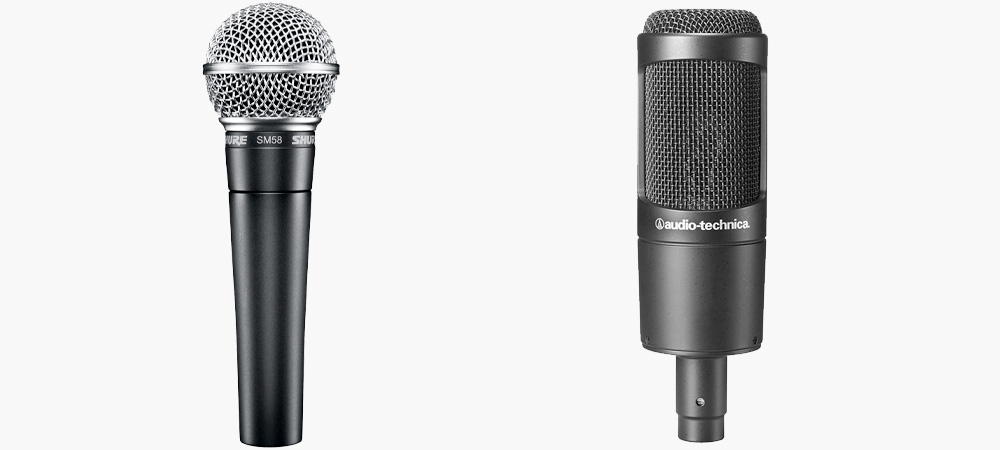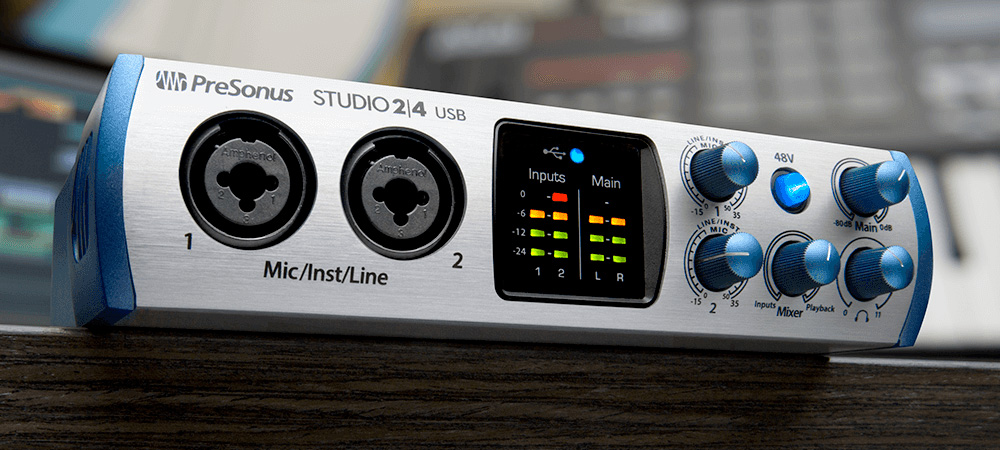Microphones
Assuming you don't already own one, you're going to need a microphone. You have a choice between USB or a more traditional mic with an XLR connection. Both have positives, USB mics can sometimes be cheaper and offer a "plug and play" style setup. USB mics are worth considering if you're new to audio recording as they're a very simple and straight forward way start capturing audio, without the need for other equipment. XLR is the industry standard and arguably offers better sound quality but as computers don't feature XLR connections you will need an audio interface to record audio from an XLR microphone into your PC, we'll look at interfaces in a minute. USB-only mics are often a great option if you're only recording one person at a time as you can run into complications recording multiple USB mics at once, especially if you're not experienced with setting up audio and routing it within your PC. So if you plan on recording multiple people live on your podcast, we'd suggest XLR mics. Finally, you can always look at mics that have both USB and XLR connections, which will allow you more flexibility and versatility in the long run, but the variety of options in this category isn't as great.
Another consideration is whether you choose a dynamic or condenser style microphone. Dynamic mics are hardy, rugged and give you great sound isolation. While condenser's will offer a little extra clarity and detail, but are generally more sensitive and will pick up more environmental noise. Condenser microphones also require external power from an audio interface, mixer or in some cases your computer. This choice is best considered in the context of where you'll be recording. If you'll be in an isolated, quiet space or perhaps a treated room you could go condenser. A dynamic mic may give you more flexibility, especially if you want to record on location. For more info on dynamic vs condenser and the basics of microphones, check out our blog post "Microphones - A Quick Look"
Accessories
There's really only two accessories you may need to accompany your microphone: a shock mount/mic stand and a pop filter. You can't be handling your microphone while recording as the sound will be picked up through the body of the mic and ruin your audio. So, if the mic you choose doesn't include a stand, you should pick one up. What kind of stand you'll need depends on the model of mic you choose - a Shure SM58 dynamic mic will attach to a standard mic stand via the included mic clip but something like the RODE Podcaster is best coupled with the PSA1 boom arm and a shock mount. Boom arm's are great as they allow you to move the microphone around with minimal noise, so you can adjust the positioning relative to you rather than you moving around to accommodate the mic. A pop filter will help enhance the quality of your audio, it's a screen that sits in front of the microphone and helps eliminate "plosive" sounds (which you hear in words with 'p's or 'b's in them), which playback as unpleasant thumps in your recording.
Here's a list of some mics we think are great options for podcasting:
USB only:
Audio Technica AT2020 USB
Style: Condenser
Polar patterns: Cardioid
Notes: Audio Technica's award winning sound in a USB mic format. The AT2020 USB gives you high quality A/D conversion, a high output internal headphone amp and comes with a tripod desk stand with foldable legs for easy and portable tabletop use.
Rode Podcaster
Style: Dynamic
Polar pattern: Cardioid
Notes: Rode's dedicated podcasting mic. It's versatile, well made, features a headphone output on the body of the mic for zero latency monitoring and is USB bus powered. It also includes an internal pop filter and works fantastically when combined with the PSM1 shock mount and PSA1 Boom arm to give you a very professional home setup.
Blue Mic Yeti Studio
Style: Condenser
Polar pattern: Multi-pattern (Cardioid, Bi-directional, Omni, Stereo)
Notes: Selectable polar patterns mean you can happily record multiple people in the same room using only this microphone. Yeti also includes a built in stand and it's also a full mic/software package so you get recording (PreSonus® Studio One® Artist) and processing (iZotope Nectar Elements) programs included. These contain templates for different recording situations, great for those not overly familiar with audio post-production.
 AT2020 / / Podcaster / Yeti Pro
AT2020 / / Podcaster / Yeti Pro
XLR:
Shure SM58
Style: Dynamic
Polar pattern: Cardioid
Notes: An iconic vocal mic, the SM58 is tried and tested! Extremely rugged, it offers great sound reproduction, with a frequency response designed for vocal performance. This mic is an industry standard on stage and has been for many, many years. It's highly versatile whether in studio or on location.
Audio Technica AT2035
Style: Condenser
Polar patters: Cardioid
Notes: A side-address cardioid studio condenser delivers exceptional detail and low noise. Equipped with a switchable 80 Hz high-pass filter and 10 dB pad, the AT2035 handles high sound pressure levels with ease. The AT2035 offers great sound for it's price range and also includes a custom shock mount for attaching to a boom arm or mic stand.
 SM58 and AT2035
SM58 and AT2035
USB and XLR:
Blue Yeti Pro
Style: Condenser
Polar pattern: Multi-pattern (Cardioid, Bi-directional, Omni, Stereo)
Notes: Like the Yeti Studio the Pro offers some of the highest quality audio available from a USB microphone, has switchable polar patterns for a variety of uses and comes with all the software you need to get started. It also includes an XLR output, allowing you even greater flexibility.
Samson Q2U
Style: Dynamic
Polar pattern: Cardioid
Notes: Great podcasting option as it offers USB/XLR versatility, but also comes as a pack with accessories like a desktop tripod stand, windscreen and XLR and USB cables. The Q2U is a great option for starting a podcast as you could begin recording audio over USB and if you ever move to using an audio interface switch to the XLR out.

Yeti Pro and Samson Q2U
Audio Interfaces
If you do decide to go down the route of using XLR mic(s) you'll need an audio interface to convert the analog signal of the microphone to a digital one in your computer. An audio interface allows you a great deal of flexibility as most will offer at least two mic/line/instrument inputs, meaning it's easy to record multiple tracks of audio simultaneously. This is great if you want to do a podcast with a co-host(s) or perhaps hope to have musicians performing. Interfaces also have other benefits, such as high quality balanced outputs for connecting to speakers and studio monitors, MIDI I/O if you wish to ever delve into music production and most of all, they usually come packaged with some form of audio editing and recording software, so you can get started right away. Often these are "Lite" or entry level versions of the software, but are usually more than capable of covering the recording and editing needs of podcasting. They also include upgrade pathways that are cheaper than buying the full-version software outright, if you decide you'd like the expanded functionality.
There are a number of audio interfaces that will do the job very well, but a couple we'd recommend are the PreSonus AudioBox USB96 and the PreSonus Studio 2|4. The PreSonus interfaces have great mic pre-amps, come bundled with their Studio One® Artist software and offer features like MIDI I/O in a price range where some other interfaces don't. The Studio 2|4 in particular has the very cool feature of USB-C integration, so it's especially good for newer Mac's. Brands like PreSonus and Focusrite also offer "Studio Packs", which bundle a mic, interface, headphones and sometimes more into a very simple and cost-effective option.

Portability
If you want to record on location, or wish to have the ability to record on the fly away from your computer you could look at purchasing a portable recorder. Zoom make a great range of recorders, with the H6 being top of the range. The great thing about the H6 is that it can also be used as an audio interface, meaning you get the flexibility of high quality audio inside and outside your studio, whether recording to SD card or directly into a computer. The built in mics are also very usable in interview situations. Another option might be the IK Multimedia iRig Mic Lav, a Lavalier microphone designed for use with iOS devices. These are great for interview style content and the ease of recording with your phone or tablet is obviously a big plus! They come in singles or pairs, with the price of a two-pack reduced compared to buying two single sets separately.
 Zoom H6 and IK iRig Mic Lav
Zoom H6 and IK iRig Mic Lav
Specialised Podcasting Units
Finally, this has been a new category appearing on the market lately. These aim to offer an audio interface that replicates elements from a professional broadcast setup. The RodeCaster Pro features four high-quality mic channels and headphone outputs, USB, one touch-recording and 8 programmable pads for launching any audio on the fly (such as sound effects or ads). It allows you to connect via Bluetooth or TRRS to easily record phone interviews or play audio from your phone. The USB connection can be In or Out so you can easily receive audio, like music from your computer and mix this in on a dedicated fader.
There's also the Tascam MiNiSTUDIO. Not as feature rich as the RODE unit but more affordable, it gives you two mic-preamps, plus support for instrument 'direct in' (the RodeCaster doesn't have HI-Z inputs). Like the RODE it has dedicated software for controlling the parameters and three assignable sound effect buttons. It also has a handy "Broadcast" mode. When in Broadcast mode, the audience will hear exactly what you hear as all audio generated by the MiNiSTUDIO and/or your computer will be mixed together in a single stereo stream.
 Rode RodeCaster Pro
Rode RodeCaster Pro
Whatever equipment direction you decide to go in for your podcast, there's an option to allow you to create a great sounding, high quality product. And as always, if you have any questions feel free to get in touch or stop by a Store DJ location for more information.